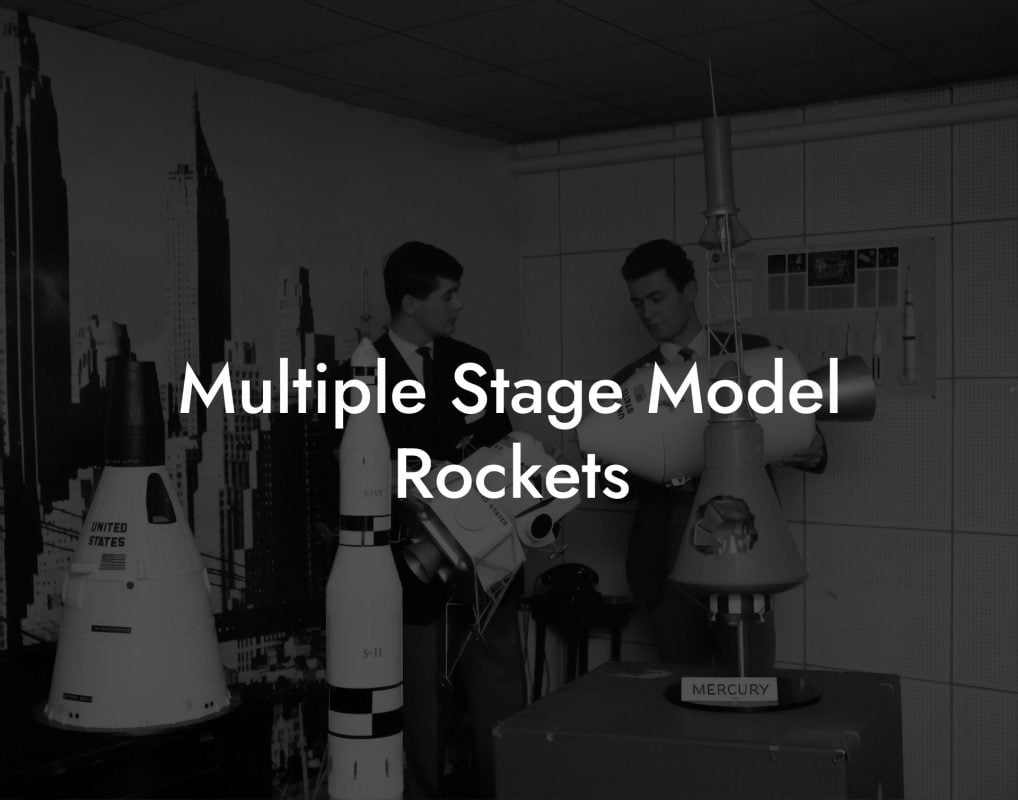Blast off into the world of model rockets! Whether you're a seasoned enthusiast or just starting your intergalactic journey, buying the right model rocket can be a daunting task. With so many options available, it's essential to know what to look for, how to choose the perfect rocket, and what accessories you'll need to take your hobby to new heights.
Quick Links to Useful Sections
- Understanding Model Rockets: A Beginner's Guide
- Types of Model Rockets: Choosing the Right One for You
- What to Look for When Buying a Model Rocket
- Essential Accessories for Model Rocketry
- Tips and Tricks for Model Rocketry Success
- Frequently Asked Questions About Model Rockets
- Resources and Community Support: Your Next Steps
Understanding Model Rockets: A Beginner's Guide
Before we dive into the world of model rockets, let's cover the basics. A model rocket is a miniature version of a real rocket, designed to mimic the look and feel of an actual spacecraft. They're typically made of lightweight materials, such as plastic or balsa wood, and are powered by small motors that propel them into the air.
Model rockets come in various shapes, sizes, and complexity levels, ranging from simple, beginner-friendly kits to advanced, high-performance rockets that require expertise and precision. When buying a model rocket, it's crucial to consider your skill level, budget, and the type of flying experience you're looking for.
Types of Model Rockets: Choosing the Right One for You
With so many types of model rockets available, it's essential to understand the differences between them. Here are some of the most popular types of model rockets:
- Beginner Rockets: Perfect for newbies, these rockets are easy to assemble and fly, with minimal complexity and cost.
- Intermediate Rockets: Suitable for those with some experience, these rockets offer more challenging builds and higher performance.
- Advanced Rockets: Designed for experienced modelers, these rockets feature complex designs, high-performance motors, and require precision assembly.
- Scale Rockets: These rockets are designed to replicate real spacecraft, with accurate details and scale proportions.
- Competition Rockets: Built for speed and agility, these rockets are designed for competitive flying and require advanced skills.
When choosing a model rocket, consider your skill level, budget, and the type of flying experience you want. If you're new to model rockets, start with a beginner-friendly kit and gradually move to more complex models as you gain experience.
Looking For The Best Model Rocket Kits? You'll Love These:
What to Look for When Buying a Model Rocket
When buying a model rocket, there are several factors to consider to ensure you get the right one for your needs. Here are some key things to look for:
- Quality of Construction: Look for durable materials, sturdy construction, and attention to detail.
- Motor Type and Power: Choose a rocket with a motor that suits your skill level and flying style.
- Recovery System: Consider a rocket with a reliable recovery system, such as a parachute or streamer, to ensure safe landings.
- Scale and Accuracy: If you're looking for a scale model, ensure it's accurate and detailed.
- Price and Value: Balance your budget with the quality and features you need.
By considering these factors, you'll find a model rocket that meets your needs and provides hours of flying fun.
Essential Accessories for Model Rocketry
To get the most out of your model rocketry experience, you'll need some essential accessories. Here are some must-haves:
- launch Pad and Controller: A sturdy launch pad and controller are necessary for safe and successful launches.
- Recovery Wadding: Use recovery wadding to protect your rocket during launch and recovery.
- Motor and Igniter: Choose the right motor and igniter for your rocket, and ensure you have spares.
- Glue and Adhesives: Use high-quality glue and adhesives to assemble and repair your rocket.
- Safety Gear: Always wear safety goggles and a launch rod to protect yourself during launches.
With these accessories, you'll be well-equipped to handle every aspect of model rocketry, from assembly to launch and recovery.
Tips and Tricks for Model Rocketry Success
To get the most out of your model rocketry experience, here are some tips and tricks to keep in mind:
- Read the Instructions: Always follow the manufacturer's instructions for assembly and flying.
- Choose the Right Weather: Avoid flying in windy or rainy conditions to ensure safe and successful launches.
- Practice Safety: Always wear safety gear and follow safety guidelines during launches.
- Join a community: Connect with other model rocket enthusiasts to learn new skills and share knowledge.
- Be Patient: Model rocketry can be challenging, so be patient and don't get discouraged by setbacks.
By following these tips and tricks, you'll be well on your way to becoming a skilled model rocketeer.
Frequently Asked Questions About Model Rockets
Here are some frequently asked questions about model rockets:
1. What is the best type of model rocket for a beginner?
The best type of model rocket for a beginner is a beginner-friendly kit, such as a starter set or an easy-to-assemble rocket.
2. How do I choose the right motor for my model rocket?
Choose a motor that suits your skill level and flying style, and ensure it's compatible with your rocket.
3. What safety precautions should I take when flying model rockets?
Always wear safety goggles and a launch rod, and follow safety guidelines during launches.
4. How do I repair a damaged model rocket?
Use high-quality glue and adhesives to repair damaged parts, and follow the manufacturer's instructions.
5. Can I build my own model rocket from scratch?
Yes, you can build your own model rocket from scratch, but it requires advanced skills and knowledge.
Resources and Community Support: Your Next Steps
Now that you've started your model rocketry journey, it's essential to connect with other enthusiasts and stay up-to-date with the latest news and trends. Here are some resources and community support options to help you along the way:
- Model Rocketry Forums: Join online forums and discussion groups to connect with other model rocketeers and learn from their experiences.
- Local Model Rocketry Clubs: Find local clubs and meetups to connect with other enthusiasts in person.
- Model Rocketry Blogs and YouTube Channels: Follow blogs and YouTube channels dedicated to model rocketry to stay informed and inspired.
- Model Rocketry Events and Competitions: Attend events and competitions to showcase your skills and learn from others.
By connecting with the model rocketry community, you'll gain access to valuable resources, expert advice, and inspiration to take your hobby to new heights.
Looking For The Best Model Rocket Kits? You'll Love These:
Useful Interruption: Dive deeper into the world of Model Rockets with our most popular sections. If there is anything you think is missing or anything you would love for us to write about, just give us a shout.
- Getting Started & Basics With Model Rockets
- Model Rocket Design, Build & Customization
- Model Rocket Propulsion & Engine Technology
- Model Rocket Launch Techniques & Recovery
- Model Rocket Advanced Rocketry & Innovations
- Model Rocket DIY and Customization
- Model Rocket Equipment Reviews & Digital Tools
- Community, Competitions & Education
- Model Rocket Troubleshooting & FAQs
- Model Rocket Bonus/Seasonal & Niche Topics
A group of model rocket enthusiasts gathered at a field for their weekly launch event. Among them was Dave, a seasoned builder known for pushing the limits of hobby rocketry. This time, he had outdone himself.
“Ladies and gentlemen,” Dave announced, dramatically pulling a cloth off his latest creation, “I present to you: The Kraken!”
The crowd gasped. This wasn’t just a model rocket, it was a monster. The thing stood 8 feet tall, had six clustered engines, and was covered in enough duct tape to qualify as a classified aerospace project.
“Dave,” muttered Steve, the cautious safety officer, “Have you, uh… done the math on this?”
“Math?” Dave scoffed. “I built it in my garage at 3 a.m. with parts from eBay. This is an art piece, Steve.”
The countdown began.
5…
4…
3…
2…
1…
The engines ignited with a BOOM, and The Kraken shot up… kind of. It immediately did a violent barrel roll, narrowly missing the spectators before skyrocketing at an angle that could only be described as “legally questionable.”
The crowd collectively ducked as The Kraken flew straight over the adjacent cornfield, where Old Man Jenkins, the grumpiest farmer in town, was minding his business.
KABOOM!
The rocket disappeared behind the barn. A moment later, a flaming piece of Estes igniter wire landed at Steve’s feet. The silence was deafening.
And then, an unmistakable sound echoed across the field.
Jenkins’ shotgun being cocked.
“DAVE!!!” Steve shouted. “RUN.”
And that was the day Dave invented the first-ever biologically powered rocket booster: pure adrenaline.
To this day, nobody knows where The Kraken landed, but legend has it, it still haunts the skies, terrifying unsuspecting drones and low-flying birds.















